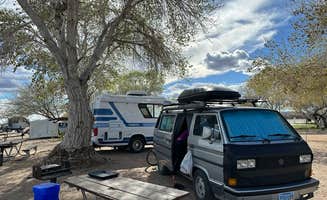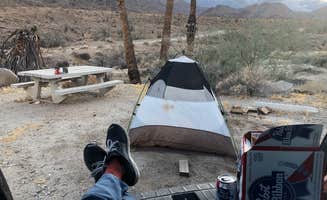Tent camping in the Palo Verde region offers remote desert experiences along the Colorado River corridor where temperatures can fluctuate by 40°F between day and night. The area sits at elevations ranging from 250 to 1,200 feet and contains numerous washes that can flood during rare desert rainstorms. Most dispersed camping locations require vehicles to navigate unpaved roads that deteriorate significantly after precipitation.
What to do
Explore petroglyph sites: Corn Springs Campground provides access to ancient Native American rock art. According to Dan X., "There's a little hike from the campground and an abandoned cabin to check out nearby. 2WD can make it just fine, but probably good to have AWD/4WD after a heavy rain."
Cool off in the Colorado River: Cibola National Wildlife Refuge East provides direct river access. Susie notes, "They have a small swimming beach like area," which makes it ideal for escaping summer temperatures.
Wildlife viewing: Bird watching opportunities abound throughout the region. Kathy B. shares that Cibola National Wildlife Refuge East is a "short drive to the wildlife refuge for bird watching. Lots of birds!"
Off-road adventuring: The Imperial Sand Dunes Recreation Area offers extensive terrain for motorized recreation. Hayden G. reports, "There are places to rent ATVs and side by sides if you don't have your own."
What campers like
Astronomical viewing: The lack of light pollution makes stargazing exceptional from November through March when skies are clearest.
Riverfront camping: Many campers appreciate the water access at Cibola National Wildlife Refuge East. As Kathy B. notes, "It's right on the river. Sites have picnic table and grill and fire pits."
Desert solitude: For those seeking isolation, Black Mountain Road Camp delivers quiet experiences. Bubble G. writes, "Here we found quiet solitude and a cooler evening, perhaps the winds helped. Lovely sunrise and sunset 360 views."
Minimal restrictions: Most dispersed camping areas have flexible rules. Terry B. mentions at Corn Springs Campground there are "About 8-10 sites, most have level spots for car or tent. Small section of petroglyphs, unfortunately some have been ruined with graffiti."
What you should know
Temperature extremes: Prepare for dramatic temperature shifts, particularly between October and April. Richard D. recalls at Corn Springs, "One night we slept there it was so dang hot at night that we slept out on the ground with our dog as opposed to inside the camper van."
Water availability: Drinking water sources are extremely limited. Paul A. at Corn Springs Campground warns, "Well was dry, luckily I carry water."
Sand driving techniques: Many access roads require specialized driving skills. As Graham W. explains about Wiley Wells Dispersed, "There is a lot of soft sand you cannot get around. Recommend ONLY 4WD and knowledge of how to drive on sand. I had traction mats & compressor to pump tires back up."
Road conditions: Most routes to dispersed camping deteriorate quickly. Bubble G. notes reaching Black Mountain Road Camp requires "about 2 miles of wash boards before turning down the camping road."
Tips for camping with families
Cacti awareness: Small desert plants can damage equipment and children. Bubble G. advises, "If you have furry friends keep a watch for their paws, there's small cacti/pokeys scattered about."
Season selection: Winter and early spring provide safest temperature ranges for family camping. Taylor shares that Corn Springs "was really hot so we'd only go back during winter time."
Wildlife encounters: Nocturnal desert animals may approach camp. Richard D. recounts, "One night we slept there... only to be woken up and surrounded by coyotes. Two of them close and three or four more off in the distance about 15 or 20 feet."
Entertainment planning: Bring all recreational equipment as stores are distant. Raymond B. suggests for Glamis Flats, "Bring your bikes and have a blast."
Tips from RVers
Level parking considerations: Finding flat spots can be challenging in desert terrain. Jennifer D. notes at Glamis, "RVs are parallel parked, several deep. Mostly dunes vs washes."
Hookup absence: No developed hookups exist in the area. Jennifer D. states there are "no trees (as it's in the desert) nor any RV hookups."
Boondocking requirements: Extended stays require complete self-sufficiency. The free camping at Cement Flats prompted Jen H. to note, "Great boondocking site on our drive to San Diego! You can't beat the price!"
Road clearance: High-clearance vehicles are recommended for accessing the best tent camping near Palo Verde, California. Katie O. observes that Glamis is "very popular with OHV and is pretty empty in the summer due to the extreme heat."



